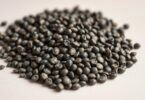Many pet parents stare at their pantry shelves, wondering which human foods might safely nourish their four-legged companions. Lentils—those tiny, lens-shaped legumes—often spark curiosity. Packed with protein and fiber, they’ve fueled civilizations for millennia. But does this ancient superfood belong in modern dog bowls?
These nutrient-dense seeds have recently gained attention as alternative ingredients in commercial pet foods. Their affordability and sustainability make them appealing to eco-conscious owners. However, introducing new elements to a pet’s diet requires thoughtful consideration.
Proper preparation proves essential. Soaking and cooking lentils breaks down complex compounds that could challenge canine digestion. Portion control also matters—too many might lead to gastrointestinal discomfort, while moderate amounts could offer health benefits.
This guide combines nutritional science with practical advice, helping you make informed choices for your furry friend. Upcoming sections explore safety protocols, cooking techniques, and vet-approved recipes. Always consult a veterinarian before making dietary changes—they’ll assess your pet’s unique needs.
Whether you’re exploring homemade meals or simply curious about occasional treats, this resource balances enthusiasm with caution. Let’s unravel the facts behind lentils and canine nutrition together.
Understanding Lentils: Nutrition and Varieties
Lentils, small yet nutrient-packed seeds, have fueled human meals for over 8,000 years. Classified as legumes, these edible powerhouses grow in pods and come in vibrant hues like green, red, and black. Their versatility in global cuisines makes them a fascinating subject for pet nutrition exploration.
What Are Lentils?
Different types vary in texture and cooking time. Red lentils soften quickly, while brown ones hold their shape. Green varieties offer earthy flavors, and black lentils (beluga) provide visual contrast. Each type brings unique qualities to recipes, though all share a common nutritional foundation.
Key Nutrients and Benefits
These legumes deliver 18 grams of protein per cooked cup, alongside iron and B vitamins. Soluble fiber supports digestive health, while plant-based compounds may reduce inflammation. For pets, these elements can enhance energy levels and gut function when used thoughtfully.
Historical data shows lentils formed 13% of ancient Mediterranean diets. Today, they remain a sustainable protein source. When adding them to a pet's meals, balance is crucial. They should never replace meat entirely but can supplement high-quality animal proteins.
Proper preparation unlocks their benefits. Always cook them thoroughly and avoid seasonings. Pairing lentils with other nutrient-rich ingredients creates a complete dietary profile. Consult your veterinarian to determine appropriate portions for your companion’s needs.
Safety Considerations in Feeding Lentils to Your Dog
Preparing legumes for pets requires precision. Raw legumes contain lectins and phytates—natural compounds that interfere with nutrient absorption. These antinutrients can cause digestive upset if not neutralized through proper cooking.
Proper Cooking Methods for Lentils
Start by rinsing dry legumes to remove debris. Soak them overnight in water—this softens the seeds and reduces cooking time. Boil soaked legumes for 20-30 minutes until tender. Undercooked varieties may lead to gas or bloating due to resistant starches.
Veterinarians recommend mashing cooked legumes into a paste for easier digestion. Mix small portions with regular meals—no more than 10% of daily intake. Introduce this ingredient gradually to monitor tolerance.
Avoiding Harmful Seasonings and Additives
Human recipes often include onions, garlic, or excessive salt—all toxic to pets. Even mild spices like paprika can irritate sensitive stomachs. Always serve legumes plain, without oils or flavor enhancers.
Some commercial pet products incorporate pre-cooked legumes safely. When preparing homemade meals, stick to basic recipes. For guidance on other potentially risky harmful additives, consult trusted resources.
Observe your companion after introducing new ingredients. Signs like loose stools or lethargy warrant immediate veterinary consultation. Proper preparation and moderation help maintain digestive harmony.
can dogs eat lentils? Addressing the Common Questions
Introducing new ingredients to a pet's diet requires balancing nutritional value with digestive tolerance. When prepared correctly, these legumes offer a safe supplement to commercial foods. The key lies in preparation methods and portion control.
Moderation and Digestive Health
Rich in plant-based protein, cooked lentils support muscle maintenance and energy levels. Their soluble fiber promotes healthy digestion when included in small quantities. Overdoing it, however, may lead to gas or loose stools due to excess starch.
Veterinary nutritionists suggest limiting legumes to 10% of daily food intake. For a 30-pound companion, this equals about two tablespoons per meal. Start with half this amount to assess tolerance.
Excessive portions interfere with mineral absorption by binding to nutrients like zinc. This underscores the importance of measured servings. Pairing them with animal proteins creates balanced meals rather than replacements.
Gradual introduction helps prevent gastrointestinal surprises. Mix a teaspoon of mashed cooked lentils into regular meals for three days. Watch for changes in stool quality or appetite before increasing portions.
Trusted sources like the Journal of Animal Science confirm that moderation enhances benefits while minimizing risks. Always prioritize your furry friend's unique needs through observation and professional guidance.
Incorporating Lentils into a Balanced Dog Diet
Creating nutritious meals for four-legged companions involves strategic ingredient pairing. This legume works best as a supplemental fiber and protein source rather than a primary component. Commercial pet foods often blend it with meats and vegetables to meet nutritional standards set by veterinary organizations.
Pre-packaged options simplify portion control, with brands like Blue Buffalo and Purina Pro Plan offering formulas containing this plant-based ingredient. Homemade recipes allow customization but require careful balancing. Always combine cooked legumes with high-quality proteins like chicken or beef to maintain amino acid diversity.
Optimal Serving Sizes and Frequency
Veterinary nutrition guidelines suggest limiting this ingredient to ¼ cup per 20 pounds of body weight weekly. Split servings across multiple meals to aid digestion. For a 40-pound pooch, add one tablespoon to dinner three times weekly.
Rotate legumes with other fiber sources like pumpkin or sweet potato to prevent dietary monotony. Track your companion’s energy levels and stool quality during transitions. Adjust quantities if you notice reduced appetite or gastrointestinal changes.
Pairing strategies matter as much as measurements. Mix mashed legumes with scrambled eggs for breakfast or stir them into ground turkey stew. These combinations ensure your furry friend receives complete nutrition without overloading their system with plant-based proteins.
Potential Risks and Digestive Implications of Lentils in Dog Diets
While lentils offer nutritional benefits, improper use may disrupt a pet’s digestive system. These legumes contain complex carbohydrates that some animals struggle to break down efficiently. Overfeeding or inadequate preparation often leads to uncomfortable symptoms, making portion control and cooking methods critical.
Recognizing Signs of Digestive Discomfort
Watch for bloating, excessive gas, or loose stools after introducing lentil-based meals. Some pups show reduced appetite or lethargy when their system reacts poorly. These issues often stem from sudden dietary changes or portions exceeding 10% of daily intake.
Persistent diarrhea or vomiting requires immediate attention. Even properly cooked varieties might irritate sensitive stomachs if introduced too quickly. Track your furry friend’s reactions for three days after serving new recipes.
When to Consult Your Veterinarian
Contact a professional if symptoms last over 24 hours or worsen. Blood in stool, severe abdominal pain, or refusal to eat signal urgent concerns. Vets may recommend eliminating lentils temporarily or adjusting meal plans.
Though non-toxic, these legumes shouldn’t dominate a balanced diet. Pair them with high-quality dog food and animal proteins for optimal nutrient absorption. Gradual transitions help maintain digestive harmony while exploring new ingredients.
Lentils in Commercial Dog Foods and Homemade Recipes
Pet nutrition trends increasingly feature plant-based ingredients, with lentils appearing in both store-bought formulas and kitchen creations. Their versatility makes them valuable for balancing protein and fiber in meals. However, preparation and pairing strategies differ between mass-produced and home-cooked options.
Lentils as an Ingredient in Packaged Dog Food
Major brands like Taste of the Wild and Wellness CORE use cooked lentils to boost nutritional content. These products combine legumes with animal proteins, grains, and vegetables for balanced meals. Manufacturers pressure-cook lentils to enhance nutrient absorption while breaking down hard-to-digest fibers.
Simple Homemade Lentil Recipes for Your Pooch
Red lentils work best for DIY meals due to their quick cooking time and soft texture. Try mixing ½ cup boiled red lentils with ground turkey and steamed carrots. Mash the blend for easy digestion, serving 1-2 tablespoons per 15 pounds of body weight.
Always rinse and simmer legumes thoroughly before adding them to recipes. Pair them with zinc-rich foods like beef to counterbalance natural phytates. Check commercial food labels to assess lentil proportions—quality products list them as supplemental ingredients rather than primary components.
Wrapping It Up: Best Practices for a Nutritious Dog Diet
Smart supplementation can enhance your companion’s meals when done thoughtfully. Legumes like green lentils provide a valuable source of plant-based protein and fiber but require thorough cooking to ensure safety. Always avoid harmful seasonings, opting for plain preparations that support canine health without digestive risks.
Commercial pet foods simplify this process with pre-cooked, vet-approved formulas. Homemade recipes offer flexibility but demand strict adherence to proper rinsing, soaking, and portion guidelines. Whether using store-bought or DIY meals, these ingredients should complement—not replace—high-quality animal proteins.
Start with small servings, such as a teaspoon mixed into regular food, and monitor your furry friend’s response. Gradually increase quantities only if tolerated well, keeping weekly intake below 10% of their diet. Pairing legumes with zinc-rich meats helps counterbalance natural compounds that affect nutrient absorption.
Consult your veterinarian before making dietary changes, especially for pets with sensitive stomachs or health conditions. Trusted resources and professional guidance ensure every meal supports vitality. A balanced, informed approach keeps tails wagging and bodies thriving for years to come.
FAQ
Are lentils toxic to pets?
No, lentils aren’t toxic when prepared plainly. However, uncooked varieties contain lectins that may cause digestive upset. Always serve fully cooked legumes without spices or additives.
How should lentils be prepared for canine consumption?
Boil them until soft (25-30 minutes) without salt, garlic, onions, or oils. Mash or blend for easier digestion, especially for smaller breeds. Avoid canned versions with added sodium.
Can seasonings like turmeric harm my pet?
Yes. Many spices irritate a dog’s stomach. Stick to plain preparations—seasonings meant for human diets often contain ingredients like onion powder that are unsafe for animals.










Leave a Comment